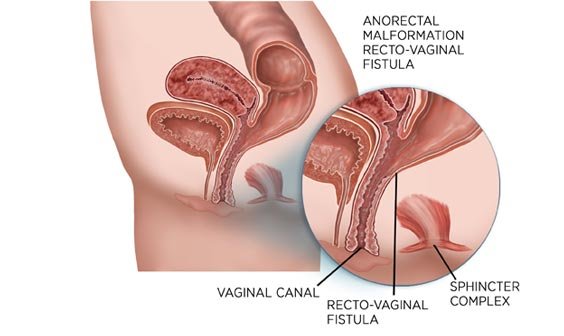Symptoms of Vaginal Fistula
- Vaginal or urinary tract infections that keep coming back
- Hygiene problems
- Stool or gas that leaks through the vagina
- Irritated or inflamed skin around your vagina or anus
- An abscess -- a swollen clump of infected tissue with pus that could be life-threatening if it’s not treated
- Fistulas that come back
Major Causes
- Abdominal surgery (hysterectomy or C-section)
- Pelvic, cervical, or colon cancer
- Radiation treatment
- Bowel disease like Crohn’s or diverticulitis
- Infection (including after an episiotomy)
- Traumatic injury, such as from a car accident
Diagnosis of Vaginal Fistula
To diagnose a vaginal fistula, your doctor likely will perform a pelvic exam, discuss your medical history and identify possible risk factors, such as recent pelvic surgery, an infection or pelvic radiation.
The following diagnostic procedures may be performed-
- Dye test. In this test, your doctor fills your bladder with a solution dye and asks you to cough or bear down. If you have a vaginal fistula, leakage will appear in your vagina.
- Cystoscopy. During this exam, your doctor uses a cystoscope — a hollow device equipped with a lens — to view the inside of your bladder and urethra, the tube that carries urine outside of your body, for signs of possible damage.
- Retrograde pyelogram. In this test, your doctor injects dye through your bladder into the tubes that connect your bladder to your kidneys (ureters) and then takes an X-ray. The X-ray image can show your doctor whether you have leakage between a ureter and your vagina.
- Fistulogram. A fistulogram is an X-ray image of your fistula. This test may help your doctor determine whether you have one or many fistulas.
- Flexible sigmoidoscopy. During this test, your doctor uses a sigmoidoscope — a thin, flexible tube with a tiny video camera at the tip — to inspect your anus and rectum.
- Computerized tomography (CT) urogram. During this test, your doctor injects dye into a vein and takes CT scans to create cross-sectional images of your vagina and urinary tract.
- Magnetic resonance imaging (MRI). MRI uses a magnetic field and radio waves to create detailed images of the organs and tissues within your body. With a pelvic MRI, your doctor can determine the path of a rectovaginal fistula.
Treatment for Vaginal Fistula available at Santhosh Hospital
Some fistulas may heal on their own. If it’s a small bladder fistula, your doctor might want to try putting a small tube called a catheter into your bladder to drain the pee and give the fistula time to heal by itself.
Most vaginal fistulas require surgery to repair the abnormal opening. Doctors can treat vaginal fistulas with surgery through the vagina or abdomen. Some cases can be treated with minimally invasive surgery (laparoscopic surgery), including robotic surgery.
The location of your fistula determines whether your surgeon can perform the procedure through your vagina or your abdomen.



